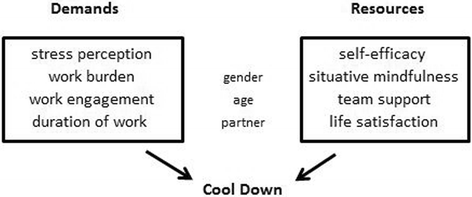Work stress associated cool down reactions among nurses and hospital physicians and their relation to burnout symptoms
- PMID: 28797258
- PMCID: PMC5553651
- DOI: 10.1186/s12913-017-2445-3
Work stress associated cool down reactions among nurses and hospital physicians and their relation to burnout symptoms
Abstract
Background: Hospital staff experience high level of work stress and they have to find strategies to adapt and react to it. When they perceive emotional exhaustion and job dissatisfaction in response to constant work stress, one reaction might be emotional withdrawal. This emotional distancing can be seen as an adaptive strategy to keep 'functionality' in the job. Both, perception of emotional exhaustion and emotional distancing as a strategy, can be operationalized as 'Cool Down'. We assume that work stress associated variables are positively associated with Cool Down reactions, while internal and external resources are negatively associated and might function as a buffer against emotional distancing. Moreover, we assume that the perception of stress and work burden might be different between nurses and physicians and women and men, but not their cool down reactions as a strategy.
Methods: Anonymous cross-sectional survey with standardized instruments among 1384 health care professionals (66% nurses, 34% hospital physicians). Analyses of variance, correlation and also stepwise regression analyses were performed to analyze the influence of demands and resources on Cool Down reactions.
Results: As measured with the Cool Down Index (CDI), frequency and strength of Cool Down reactions did not significantly differ between women and men, while women and men differ significantly for their burnout symptoms, stress perception and perceived work burden. With respect to profession, Cool Down and stress perception were not significantly different, but burnout and work burden. For nurses, "Emotional Exhaustion" was the best CDI predictor (51% explained variance), while in physicians it was "Depersonalization" (44% explained variance). Among putative resources which might buffer against Cool Down reactions, only team satisfaction and situational awareness had some influence, but not self-efficacy expectation.
Conclusion: The perceptions of emotional exhaustion and distancing of nurses and physicians (and women and men) seems to be different, but not their adaptive Cool Down reactions. Data would support the notion that a structural approach of support would require first to control and eliminate work stressors, and second a multifaceted approach to strengthen and support hospital staff's resources and resilience.
Keywords: Burnout; Cool down reactions; Nurses; Patient interaction; Physicians; Stress perception; Survey.
Conflict of interest statement
Ethics approval and consent to participate
The study was approved by the IRB of the Witten/Herdecke University (#59/2013 and #25/2014).
We provided an information sheet which described the background of the study, guaranteed anonymity, assured confidentiality, and stated that respondents have the option to fill either an online tool or could receive a print version. Consent was assumed upon completion of the anonym questionnaire.
Competing interests
AB and DL are employees of the Witten/Herdecke University, and did not receive any financial support to run this study. ZF and CS received financial support by public trusts for their subsistence during their employment as doctoral candidates at the Witten/Herdecke University. The authors declare that they have no conflict of interest.
Publisher’s Note
Springer Nature remains neutral with regard to jurisdictional claims in published maps and institutional affiliations.
Figures
References
-
- Blum K, Müller U. Dokumentationsaufwand im Ärztlichen Dienst der Krankenhäuser. Bestandsaufnahme und Verbesserungsvorschläge, Repräsentativerhebung des Deutschen Krankenhausinstituts. Das Krankenhaus. 2003;7:544–548. - PubMed
-
- Stausberg J, Lehmann N, Kaczmarek D, Stein M. Einheitliches Kodieren in Deutschland: Wunsch und Wirklichkeit. Krankenhaus. 2005;97:657–662.
-
- Diefert K, Rapp B. DRG-Dokumentation: Hoffnung für genervte Ärzte. Deutsches Ärzteblatt. 2008;105:A121–A122.
MeSH terms
LinkOut - more resources
Full Text Sources
Other Literature Sources
Research Materials



